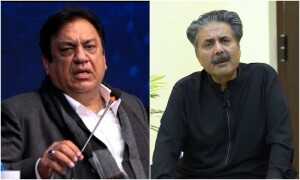
WHILE the verdict on the Panama Papers case commands the national attention these days, another issue of potential game-changing significance is taking shape beneath the headlines. The return of load-shedding, the emblem of an intense power crisis that the country has been in the grip of for almost a decade now, has cast a shadow over the electoral prospects of the PML-N in 2018.
The elimination of load-shedding was a central plank of the party’s campaign in 2013. Those elections were held under the cloud of 16-hour-long power outages in many areas that were crucial constituencies. The PML-N ran with the promise that they would ‘eliminate’ this problem once and for all.
For a brief while, it looked like the party was on its way to delivering on the promise. It inaugurated its term in office with a historic retirement of the circular debt — that mountain of unpaid bills to private power producers that had choked the power sector. The problem then, as it is now, was not so much a shortage of generation capacity. It was a shortage of funds with which to plug the many financial holes that had riddled our power sector.
Load-shedding is not the result of power shortages as much as it is the result of financial shortages and a governance deficit.
Having retired the entire circular debt in one go, the party then made a promise to the country that this would be the last such exercise. From here on, we were told, the power sector would be reformed and generation capacity added to ensure that it became financially self-sustaining while growing to meet demand at the same time. The details of those reforms were given to the IMF as part of the country’s application for a loan in September 2013, and included privatisation and pricing reform, amongst much else.
Then came the China-Pakistan Economic Corridor (CPEC), that far-reaching enterprise that was recently described by the Planning Commission as “a miraculous happening” in a Tweet. That project was going to add 16,000 megawatts of electricity to the grid, we were told, along with a vast investment in transmission to enable the system to actually carry the augmented megawatts. Now our problems would be solved forever.
With the arrival of CPEC power projects, almost all talk of reforms fell by the wayside. All eggs were now squarely in the CPEC basket and it became nearly impossible to talk to any government minister about the economy without CPEC coming into the conversation. The augmented megawatts would solve all our problems, we were told.
Here is how the game began to shape up after that: get the megawatts installed on a fast-track basis, before 2018. Before the expiration of the government’s term, all the new power projects under the ‘early harvest’ scheme of CPEC should be up and running. Then rev up those turbines at full capacity, and just like that, load-shedding will disappear. Then hit the campaign trail and, at every rally, ask the electorate this question: “Did I not promise to eliminate load-shedding if you give me your vote? Is there load-shedding in your homes now? See! I have eliminated load-shedding, just like I said I would! Now give me your vote one more time, and I will eliminate poverty, unemployment,” and so on.
This was more a political strategy than a power-sector growth plan. The only problem is it had a potentially fatal flaw.
The flaw is this: load-shedding is not the result of power shortages as much as it is the result of financial shortages and a governance deficit. Simply adding more megawatts to an outmoded system that is difficult to keep operational in the best of circumstances only adds more megawatts to the problem. It does not solve the problem.
The way it could work out in reality could be very different. With all projects installed, there could be large technical problems at the outset, just like what happened in the Nandipur power plant, making them difficult to get operational. Second, a shortage of funds could render the scheme inoperative, just like what happened in 2013, leading to plant closures due to fuel shortages, or large accumulation of arrears to private operators, again just like what happened in 2013.
But the largest weakness in the plan is the fact that for three months leading up to the election itself, there will be an interim government. Unless the Panama verdict has upended things, that interim government will come in June and rule till early September, the crucial summer months when heat and monsoon can lay waste to the best-laid plans.
I’m willing to bet the government will do its best to leave behind a massive stockpile of fuel, and massively retire all outstanding payments to private power producers before handing power over to the interim government, because these are the two things that could cause the power sector to choke up at the crucial moment when its smooth functioning will matter the most. Since the handover of power will happen in June, before the fiscal year has closed, the retirement will be reflected in the fiscal deficit figures of the government’s last year, which could blow all targets as a result.
But should a large-scale payment or fuel stock deterioration take place during those crucial months, or an unexpected event like the unusually hot April days that we are currently witnessing and that have cause a massive spike in power demand, load-shedding could still return since the ability of the interim government to effect a large, strategic intervention to keep the turbines turning smoothly will be limited.
If this happens, it could cost the PML-N- heavily in the polls. And that would be the irony of the decade, because their exit from power would mirror almost exactly the circumstances of their arrival into power. All along one had hoped that they had a vision beyond raw megawatts when they promised to ‘eliminate load-shedding’. But it turns out they don’t. Now let’s wait and see how that works out for them.
The writer is a member of staff.
Twitter: @khurramhusain
Published in Dawn, April 20th, 2017














































